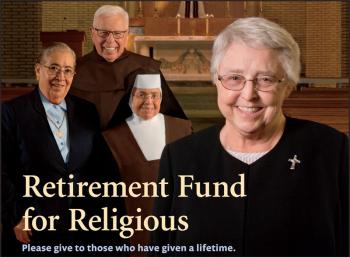Catholics in the Diocese of Allentown will have the opportunity to “give to those who have given a lifetime” as part of the collection for the Retirement Fund for Religious, to be held in parishes Dec. 9-10.
Coordinated by the National Religious Retirement Office (NRRO) in Washington, D.C., the annual appeal benefits 32,000 elderly Catholic sisters, brothers and religious order priests whose religious congregations lack adequate retirement funding.
Last year, the Diocese of Allentown contributed $33,567.76 to the collection.
In 2017, the Bernardine Franciscan Sisters, Cistercian Fathers, Missionary Sisters of the Most Sacred Heart and Missionary Sisters of the Precious Blood received a combined total of $285,943.70 in financial assistance made possible by the Retirement Fund for Religious.
Additionally, the Diocese of Allentown, in conjunction with the Archdiocese of Philadelphia and the Diocese of Harrisburg, also distributes funding to local religious communities to support retirement needs.
The 2016 collection raised almost $30.7 million. Roughly 94 cents of every dollar aids senior religious. In June, the NRRO distributed $25 million to 390 religious communities across the country.
Communities use these funds to bolster retirement savings and subsidize expenses, such as prescription medications and nursing care. Throughout the year, additional funding is allocated to assist religious communities with the greatest needs and to promote ongoing education in retirement planning and eldercare delivery.
“We are humbled and profoundly grateful for the love and support of Catholics across the nation,” said Presentation Sister Stephanie Still, the NRRO’s executive director.
Despite this generosity, many religious communities still struggle to provide for aging members. Only 41 of the 539 communities submitting data to the NRRO in 2016 were adequately funded for retirement.
Traditionally, Catholic sisters, brothers and religious order priests – known collectively as religious – served for small stipends that did not include retirement benefits. Today, hundreds of religious communities lack sufficient retirement savings.
Compounding the funding shortage are the rising cost of care and the decrease in income that has resulted from the declining number of religious able to serve in compensated ministry.
In addition to providing assistance for day-to-day needs, collection proceeds underwrite initiatives to help religious communities address the factors underlying their retirement shortfalls. These efforts have facilitated solutions such as collaborative care facilities, strategic partnerships with health-care providers and numerous cost-saving measures.
“I visit many religious communities and see the good works that members young and old provide,” said Sister Still.
“Generosity to the annual collection ensures our office can furnish support to help these communities care for older members while continuing their ministries and witness.”
Click here to learn more.
About the Retirement Fund for Religious
Why We Ask
In 1988, Catholic bishops of the United States launched the Retirement Fund for Religious (RFR) to address the significant lack of retirement funding for Catholic sisters, brothers, and priests in religious orders.
- For most of their lives, elder religious worked for little to no pay. There were no 401(k) plans or pensions.
- Religious communities are financially responsible for the support and care of all members. Income, earnings, and expenses are managed separately from the parish and diocesan structures of the Catholic Church.
- The funding shortage is compounded by rising health care costs and decreased income. And, as more religious reach retirement age and leave compensated ministry, income will further decline while care needs increase.
- By 2027, religious past age 70 are projected to outnumber religious under age 70 by more than three to one.
- There are more than 32,000 religious past age 70 living in the United States. In 2016, the average annual cost for their care was more than $42,000 per person.
- Since 2009, the annual cost to support senior women and men religious has exceeded $1 billion.
- In 2016, 67 percent of the religious communities providing data to the National Religious Retirement Office (NRRO) had a median age of 70 or higher.
- The average annual Social Security benefit for a religious is $6,116.22, while the average U.S. beneficiary receives $16,321.56.
How Donations Help
Catholics in the United States have donated more than $816 million to the RFR since the first appeal.
- Roughly 94 percent of donations to the RFR aid elder religious, with the remainder used to administer and promote the appeal.
- Since 1989, more than $775 million has been distributed to support the day-to-day care of elderly sisters, brothers, and religious order priests. An additional $91 million has been allocated toward self-help projects initiated by religious communities, including collaborative health care facilities.
- In addition to direct financial assistance, proceeds from the annual appeal underwrite educational programming, services, and resources that enable religious communities to evaluate and prepare for long-term retirement needs.
- Support from the Retirement Fund for Religious helps religious communities care for senior members while continuing important ministries to the People of God.








